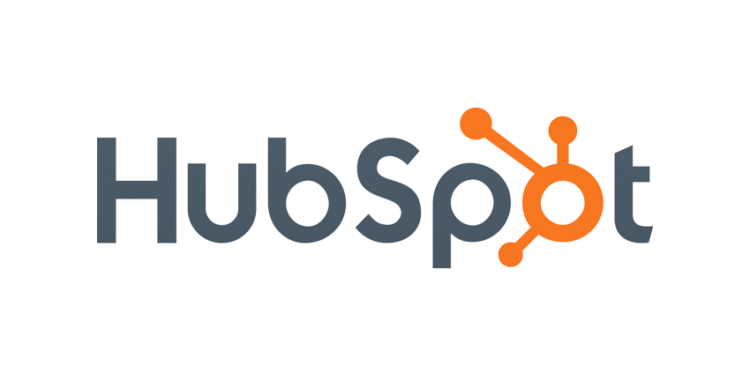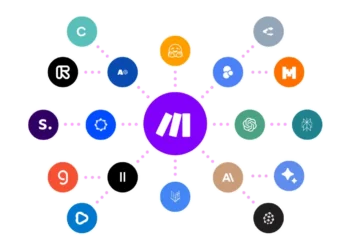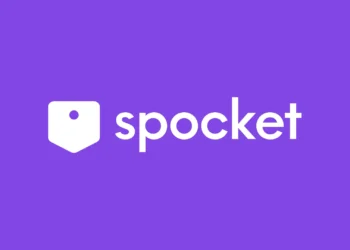What if you could streamline your business operations, boost productivity, and provide personalized customer experiences all in one place? With HubSpot, an inbound marketing software and CRM platform, you can. By integrating advanced artificial intelligence features across its Sales, Marketing, and Service Hubs, HubSpot has enhanced its platform to help businesses achieve their goals. But how can you maximize HubSpot for your business?
Key Takeaways
- HubSpot is an inbound marketing software and CRM platform that can help businesses streamline operations and boost productivity
- Implementing HubSpot CRM integrations can reduce manual data entry by approximately 80%
- HubSpot’s advanced AI features can help provide personalized customer experiences
- Businesses report a 23% increase in team collaboration when using HubSpot
- Companies that automate repetitive tasks through HubSpot can free up to 30% of employee time for strategic work
- HubSpot’s API can improve data synchronization efficiency by 15-25% over native mapping capabilities
By following this guide, you’ll learn how to maximize HubSpot for your business, from getting started with the platform to using its advanced features to drive growth and revenue.
Introduction to HubSpot and Its Benefits
HubSpot is an inbound marketing software that provides a range of tools for marketing, sales, and customer service. Its features include marketing automation, customer relationship management, and email marketing. With its AI features, HubSpot can help businesses streamline their operations and provide personalized customer experiences.
According to recent data, HubSpot CRM has been adopted by over 30,000 companies across 90 countries, and the global CRM software market is forecast to grow to approximately 57 billion U.S. dollars by 2025. This growth represents a significant increase in the demand for customer relationship management solutions, and HubSpot is well-positioned to meet this demand with its robust features and scalable pricing plans.
What is HubSpot?
HubSpot is a comprehensive platform that offers a range of tools and features to help businesses manage their marketing, sales, and customer service activities. Its marketing automation features allow businesses to automate repetitive tasks, such as email marketing and lead nurturing, while its customer relationship management features provide a centralized database for customer interactions and data.
Overview of HubSpot’s Features
HubSpot’s features include email marketing, marketing automation, and customer relationship management. Its email marketing tools allow businesses to create and send targeted email campaigns, while its marketing automation features enable businesses to automate lead nurturing and scoring. Additionally, HubSpot’s customer relationship management features provide a centralized database for customer interactions and data, allowing businesses to better understand their customers and provide personalized experiences.
Getting Started with HubSpot: A Step-by-Step Guide
To begin using HubSpot, it’s essential to choose the right plan for your business. HubSpot offers various plans, including a free tier, that can help you manage your sales pipeline, generate leads, and drive growth through effective digital marketing. The free tier includes limited features, such as only 10 configurable properties, but it’s a great starting point for small businesses or those new to HubSpot.
When selecting a plan, consider your business needs and goals. If you’re looking to enhance your lead generation efforts, you may want to upgrade to the Starter edition, which includes more features and support for sales pipeline management. Additionally, HubSpot’s digital marketing tools can help you create targeted campaigns and track their effectiveness.
Once you’ve chosen your plan, setting up your HubSpot account is straightforward. You can customize your sales pipeline, define stages such as “Lead,” “Qualified,” “Proposal,” and “Closed,” and even automate follow-ups and task assignments. With HubSpot, you can also integrate your email services, such as Gmail or Outlook, for seamless communication and tracking.
Choosing the Right HubSpot Plan
HubSpot’s plans are designed to meet the needs of businesses of all sizes. By selecting the right plan, you can ensure that you have the features and support you need to manage your sales pipeline, generate leads, and drive growth through effective digital marketing and sales pipeline management.
Setting Up Your HubSpot Account
Setting up your HubSpot account is a crucial step in getting started with the platform. By following the step-by-step guide and choosing the right plan, you can ensure that you’re getting the most out of HubSpot’s features and tools, including lead generation, digital marketing, and sales pipeline management.
Understanding HubSpot’s CRM System
HubSpot’s CRM platform is designed to help businesses manage their customer relationships effectively. With its robust features, companies can streamline their sales process, provide personalized customer experiences, and gain valuable insights into their sales pipeline management. The CRM system allows for the management of up to 1 million contacts without any cost, making it an attractive option for businesses of all sizes.
The key features of HubSpot’s CRM include tools for live chat, dynamic lists, lead capture forms, and email marketing. These features enable businesses to manage their sales pipeline, track customer interactions, and analyze sales performance. By leveraging these tools, companies can improve their customer relationship management and ultimately drive more sales.
Key Features of HubSpot CRM
HubSpot’s CRM provides a range of features that cater to the needs of sales teams. The Sales Hub includes functionalities like managing multiple sales pipelines and providing sales performance dashboards to track success. Additionally, the CRM system allows for the segmentation of audiences, leading to personalized communications on a 1-to-many scale through automated workflows.
How to Import Contacts into HubSpot
Importing contacts into HubSpot is a straightforward process. Businesses can upload their contact lists from various sources, such as spreadsheets or other CRM systems. Once the contacts are imported, companies can start managing their sales pipeline, tracking customer interactions, and analyzing sales performance using HubSpot’s CRM platform.
Effective Marketing Strategies Using HubSpot
Businesses can create effective marketing strategies that drive lead generation and growth with HubSpot. By leveraging HubSpot’s email marketing tools, companies can automate and personalize customer experiences. According to recent data, 70% of marketers report that HubSpot has improved their lead generation efforts. This is because HubSpot’s AI features can help automate email marketing, providing personalized customer experiences.
HubSpot’s content management system is another key feature that enables businesses to create targeted campaigns with workflows. This helps to streamline the marketing process, ensuring that all efforts are aligned with the company’s overall goals. With HubSpot, businesses can create effective digital marketing strategies that drive lead generation and growth. By utilizing HubSpot’s tools, companies can improve their sales productivity, with some businesses seeing at least a 20% increase.
Moreover, companies using HubSpot content marketing tools generate 67% more leads per month. This is because HubSpot’s platform provides a range of tools and features that enable businesses to create and implement effective marketing strategies. By using HubSpot for email marketing, lead generation, and digital marketing, businesses can improve their overall marketing efforts and drive growth.
By setting SMART marketing goals and aligning teams to specific goals, businesses can ensure that their marketing efforts are effective and measurable. With HubSpot, companies can create a clear marketing strategy that ties efforts directly to business objectives, reducing wasted time, money, and resources. By investing in the right marketing channels and using HubSpot’s tools, businesses can achieve a high return on investment in their marketing initiatives.
Optimizing Your Sales Process with HubSpot
HubSpot is a powerful tool for optimizing your sales process, allowing businesses to streamline their sales pipeline management and improve lead generation. By leveraging HubSpot’s features, companies can enhance their digital marketing efforts and drive growth. With HubSpot, businesses can track sales performance, identify bottlenecks, and allocate resources efficiently.
One of the key benefits of using HubSpot is its ability to automate repetitive tasks, such as follow-up emails and task assignments, which can significantly increase efficiency and reduce the manual workload on sales teams. Additionally, HubSpot’s analytics tools provide insights into critical metrics such as conversion rates and sales velocity, allowing businesses to make data-driven decisions and optimize their sales process.
By integrating HubSpot with other tools, such as email marketing platforms and customer support software, businesses can streamline their workflows and enhance data consistency. This can lead to improved decision-making capabilities and increased productivity. With HubSpot, companies can also customize their sales pipeline stages, track deal properties, and automate tasks, making it an essential tool for sales teams looking to optimize their sales process and drive growth through effective sales pipeline management and lead generation in digital marketing.
How to Track Sales Performance
Tracking sales performance is crucial for optimizing the sales process. HubSpot provides tools to track various deal properties, including deal size, decision-maker, expected close date, and deal priority. By standardizing data input within deal properties, businesses can enhance data quality and improve tracking accuracy.
Using HubSpot for Lead Management
HubSpot’s lead management features allow businesses to prioritize leads based on likelihood to close, enhancing focus for sales reps. The robust lead scoring system and automated reminders reduce lost business by ensuring timely follow-ups according to deal stages in the pipeline.
Integrating Sales Tools with HubSpot
Integrating HubSpot with other sales tools can enhance the sales process. By connecting HubSpot with email marketing platforms, customer support software, and other tools, businesses can streamline workflows, improve data consistency, and increase productivity, ultimately leading to improved sales pipeline management and more effective lead generation in digital marketing.
Analyzing Your Business Performance with HubSpot Analytics
HubSpot Analytics is a powerful tool that helps businesses analyze their performance and make data-driven decisions. With its comprehensive reporting features, businesses can gain insights into their digital marketing efforts, lead generation, and sales pipeline management. According to recent data, a properly implemented HubSpot CRM integration can provide real-time reporting across all business units, enabling businesses to track their progress and identify areas for improvement.
Understanding HubSpot Reporting Features
HubSpot offers a range of reporting features that cater to different business needs. From standard reports to custom reports, businesses can measure their marketing campaign effectiveness and track their sales performance. With HubSpot’s reporting features, businesses can analyze their website traffic, contact interactions, and sales pipeline, providing valuable insights into their digital marketing efforts.
Measuring Marketing Campaign Effectiveness
By using HubSpot Analytics, businesses can measure the effectiveness of their marketing campaigns and identify areas for improvement. With its robust reporting features, businesses can track their lead generation, conversion rates, and sales revenue, enabling them to make data-driven decisions and optimize their digital marketing strategies. By leveraging HubSpot Analytics, businesses can streamline their sales pipeline management, improve their lead generation, and enhance their overall digital marketing performance.
HubSpot Integrations: Enhancing Your Workflow
HubSpot integrations can transform disconnected systems into a robust, unified ecosystem that drives growth and efficiency. With a properly implemented CRM platform, businesses can streamline their operations and enhance their customer relationship management. By integrating third-party apps, users can customize their HubSpot experience and improve their sales pipeline management.
Popular Third-Party Integrations
HubSpot’s App Marketplace lists a wide range of applications that are reviewed and certified by HubSpot’s development team. Users can connect apps to their HubSpot account, allowing them to sync data and incorporate workflow functionalities. This enables businesses to leverage the strengths of multiple tools and create a tailored CRM platform that meets their specific needs.
Customizing Your HubSpot Experience
By integrating apps with workflow functionalities, users can automate tasks and focus on high-value activities. HubSpot actively supports application providers, ensuring a seamless integration experience. With the ability to manage connected apps and their alerts, users can stay organized and make data-driven decisions to optimize their sales pipeline management and customer relationship management.
Best Practices for Using HubSpot Effectively
To maximize the potential of HubSpot, it’s essential to adopt best practices that streamline your workflow and enhance your digital marketing efforts. Effective lead generation, sales pipeline management, and overall digital marketing strategy rely on a well-organized approach. Utilizing HubSpot’s features, such as dashboards, can significantly improve your ability to track key metrics and make data-driven decisions.
Regularly updating your contact lists is crucial for maintaining a clean and accurate database. This practice not only aids in sales pipeline management but also ensures that your lead generation efforts are targeted and efficient. By integrating email marketing tools within HubSpot CRM, you can create personalized and targeted campaigns that drive engagement and conversion.
Moreover, leveraging HubSpot’s automation capabilities and workflows can help automate routine tasks, freeing up time for more strategic activities. By applying these best practices and staying up-to-date with the latest features and trends in digital marketing, businesses can optimize their use of HubSpot and drive growth through effective lead generation, sales pipeline management, and digital marketing strategies.
Staying Organized with Dashboards
HubSpot’s dashboards feature enables you to view up to 10 reports simultaneously, providing a comprehensive overview of your marketing and sales performance. By setting up automated emails for these dashboards, you can keep stakeholders informed on a weekly basis, ensuring everyone is aligned and working towards common goals.
Regularly Updating Your Contact Lists
Regular monthly maintenance, including merging duplicate records and reviewing hard-bounced email addresses, is vital for maintaining data accuracy. By establishing processes for maintaining clean data in your CRM, you can improve reporting accuracy and make more informed business decisions, ultimately enhancing your lead generation and sales pipeline management efforts.
Advanced Features in HubSpot
HubSpot offers a range of advanced features that can help businesses take their marketing to the next level. With marketing automation capabilities, companies can streamline their marketing processes, saving time and increasing efficiency. Additionally, HubSpot’s customer relationship management tools enable businesses to manage their customer interactions more effectively, providing a better customer experience.
One of the key advanced features in HubSpot is its ability to automate email marketing campaigns. This allows businesses to create personalized email campaigns that are tailored to their customers’ needs, increasing engagement and conversion rates. According to recent data, HubSpot’s AI features can help automate email marketing and provide personalized customer experiences, leading to increased customer satisfaction and loyalty.
By leveraging these advanced features, businesses can gain a competitive edge in the market, driving growth and revenue. With HubSpot’s advanced features, companies can create targeted ad campaigns, report insights, and optimize their marketing strategies, leading to improved customer engagement and conversion rates.
Training and Support Resources for HubSpot Users
As businesses strive to maximize their use of HubSpot, they often require guidance on how to effectively utilize the platform’s features. This is where training and support resources come into play, enabling teams to overcome common challenges and achieve their goals through improved lead generation, digital marketing, and sales pipeline management.
Comprehensive training is essential for higher user adoption rates, increasing proficiency in HubSpot’s features and reducing process inefficiencies. By providing tailored training, businesses can align HubSpot tools with their specific organizational workflows, accelerating the time-to-value and enabling teams to meet their goals faster. Effective training also results in cleaner data, crucial for accurate reporting and insights, and enhances collaboration among departments, improving overall alignment in using HubSpot.
HubSpot Academy offers free courses and certifications in various areas of HubSpot’s functionalities, while VisualSP provides in-app guidance and support directly within HubSpot. Additionally, community forums and onboarding services from HubSpot partners can offer tailored assistance, including hands-on training and ongoing support. By leveraging these resources, businesses can empower their teams to maximize ROI by effectively leveraging HubSpot’s capabilities to drive growth, and make data-driven decisions to allocate resources to high-ROI channels based on data, enhancing overall marketing effectiveness.
Access to HubSpot’s Community and Support
HubSpot’s community and support resources are invaluable for businesses looking to get the most out of the platform. With access to a wealth of knowledge and expertise, teams can quickly resolve common issues and stay up-to-date with the latest best practices in digital marketing and sales pipeline management, ultimately driving more effective lead generation and business growth.
Case Studies: Success Stories with HubSpot
Many notable brands have successfully implemented HubSpot to transform their business operations. By leveraging HubSpot’s CRM platform, these companies have improved their customer relationship management and sales pipeline management. For instance, Vivendex, a real estate company in Spain, increased its website visits by five times organically in just one year. Additionally, Jeeves, a financial services company in Mexico, enhanced its customer journey visibility and reduced time and inaccuracies through workflow automation and integrated marketing, sales, and customer service actions.
Other companies, such as Aquila Commercial and Yale Appliance, have also achieved significant results with HubSpot. Aquila Commercial increased its organic website traffic by 290% and grew new contact conversions by 11,350%. Yale Appliance generated $117 million in revenue from organic channels since adopting HubSpot and inbound marketing. These success stories demonstrate the effectiveness of HubSpot in driving growth and efficiency for businesses.
By analyzing these case studies, businesses can learn valuable lessons about how to implement HubSpot effectively. For example, the importance of integrating marketing, sales, and customer service actions cannot be overstated. By streamlining these processes, companies can improve their customer relationship management and sales pipeline management, ultimately driving revenue growth and efficiency. As seen in the success stories of Vivendex, Jeeves, and other companies, a properly implemented HubSpot CRM integration can transform disconnected systems into a robust, unified ecosystem that drives growth and efficiency.
Notable Brands Using HubSpot
Companies like West Roofing Systems and AIS have also experienced significant growth with HubSpot. West Roofing Systems saw a 5,252% increase in organic website sessions, while AIS increased its website traffic by 1,100% in the first year of its revised strategy with HubSpot. These success stories demonstrate the versatility and effectiveness of HubSpot in driving business growth across various industries.
Lessons Learned from HubSpot Implementations
By studying these case studies, businesses can gain valuable insights into how to maximize their use of HubSpot. By focusing on customer relationship management and sales pipeline management, companies can drive revenue growth and efficiency. With HubSpot’s CRM platform, businesses can streamline their operations and improve their overall performance, as seen in the success stories of these notable brands.
Conclusion: Making the Most of HubSpot for Your Business
As we conclude this comprehensive guide on maximizing HubSpot, it’s clear that this powerful inbound marketing software and CRM platform offers unparalleled opportunities for businesses to drive growth and achieve success. By fully leveraging HubSpot’s robust features, from advanced automation to targeted marketing campaigns, organizations can streamline their operations, enhance customer relationships, and make data-driven decisions that propel their business forward.
Looking ahead, HubSpot continues to evolve, with the integration of cutting-edge artificial intelligence (AI) capabilities across its Sales, Marketing, and Service Hubs. This strategic integration allows businesses to unlock even greater efficiencies, personalization, and predictive insights, enabling them to stay ahead of the curve in the dynamic digital landscape.
Ultimately, by embracing HubSpot and its extensive capabilities, businesses can unlock new levels of productivity, customer engagement, and revenue growth. With a steadfast commitment to ongoing learning, strategic implementation, and a data-driven approach, organizations can make the most of this robust CRM platform and position themselves for long-term success.
FAQ
What is HubSpot?
HubSpot is an inbound marketing software that provides a range of tools for marketing, sales, and customer service. It includes features such as marketing automation, customer relationship management (CRM), and email marketing.
What are the key benefits of using HubSpot?
HubSpot can help businesses streamline their operations, boost productivity, and provide personalized customer experiences. Its advanced AI features enable businesses to optimize their marketing and sales processes, generate more leads, and drive growth.
How do I get started with HubSpot?
What are the key features of HubSpot’s CRM system?
HubSpot’s CRM system allows you to import and manage your contacts, track your sales pipeline, and provide personalized customer experiences. You can use the CRM to streamline your sales process and drive growth.
How can I use HubSpot for effective marketing strategies?
HubSpot provides a range of tools for email marketing, campaign management, and content creation. You can leverage these features to generate more leads, create targeted campaigns, and measure the effectiveness of your marketing efforts.
How can I optimize my sales process with HubSpot?
How can I analyze my business performance with HubSpot Analytics?
HubSpot’s reporting and analytics tools provide in-depth insights into your marketing and sales performance. You can use these features to measure the effectiveness of your campaigns, make data-driven decisions, and optimize your business strategies.
What integrations are available for HubSpot?
What are some best practices for using HubSpot effectively?
What are some advanced features in HubSpot?
HubSpot offers a range of advanced features, including automation capabilities and A/B testing tools. These features can help you take your marketing and sales strategies to the next level, optimize your processes, and drive even greater success for your business.





